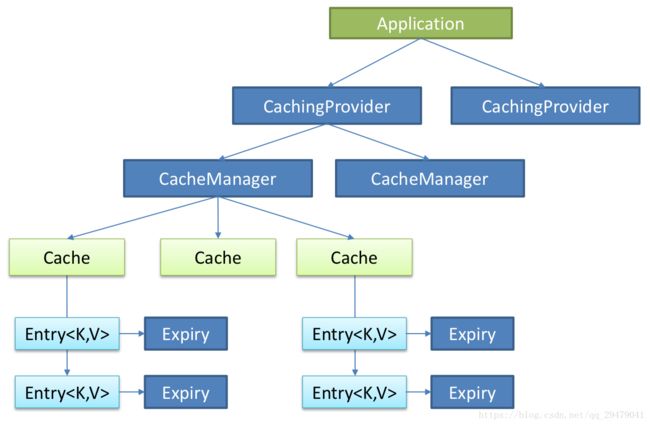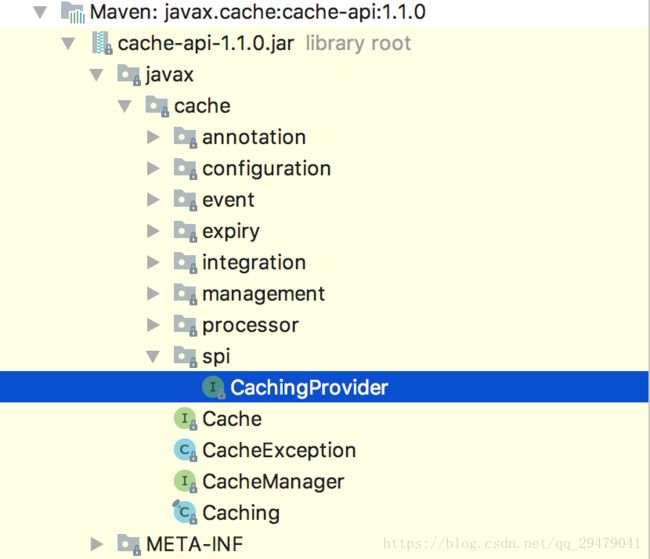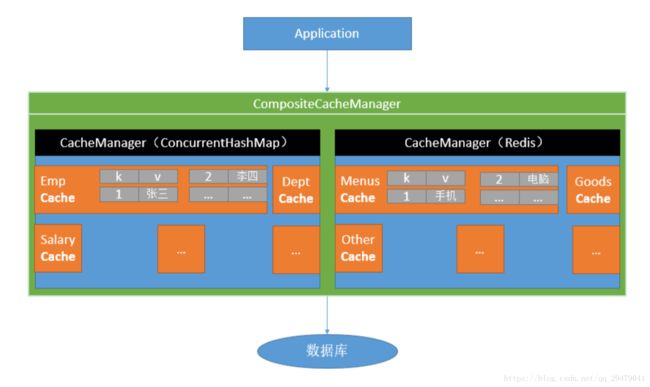十八、SpringBoot之缓存的使用及原理
一、JSR-107
Java Caching定义了5个核心接口,分别是CachingProvider, CacheManager, Cache, Entry和 Expiry。
- CachingProvider定义了创建、配置、获取、管理和控制多个CacheManager。一个应用可以在运行期访问多个CachingProvider。
- CacheManager定义了创建、配置、获取、管理和控制多个唯一命名的Cache,这些Cache 存在于CacheManager的上下文中。一个CacheManager仅被一个CachingProvider所拥有。
- Cache是一个类似Map的数据结构并临时存储以Key为索引的值。一个Cache仅被一个 CacheManager所拥有。
- Entry是一个存储在Cache中的key-value对。
- Expiry 每一个存储在Cache中的条目有一个定义的有效期。一旦超过这个时间,条目为过期的状态。一旦过期,条目将不可访问、更新和删除。缓存有效期可以通过ExpiryPolicy设置。
javax.cache
cache-api
二、Spring缓存抽象
Spring从3.1开始定义了org.springframework.cache.Cache 和org.springframework.cache.CacheManager接口来统一不同的缓存技术; 并支持使用JCache(JSR-107)注解简化我们开发;
- Cache接口为缓存的组件规范定义,包含缓存的各种操作集合;
- Cache接口下Spring提供了各种xxxCache的实现;如RedisCache,EhCacheCache ,ConcurrentMapCache等;
- 每次调用需要缓存功能的方法时,Spring会检查指定参数的指定的目标方法是否已经被调用过;如果有就直接从缓存中获取方法调用后的结果,如果没有就调用方法并缓存结果后返回给用户。下次调用直接从缓存中获取。
- 使用Spring缓存抽象时我们需要关注以下两点:
1.确定方法需要被缓存以及他们的缓存策略
2.从缓存中读取之前缓存存储的数据
三、几个重要概念&缓存注解
| Cache |
缓存接口,定义缓存操作。实现有:RedisCache、EhCacheCache、 ConcurrentMapCache等 |
| CacheManager |
缓存管理器,管理各种缓存(Cache)组件 |
| @Cacheable | 主要针对方法配置,能够根据方法的请求参数对其结果进行缓存 |
| @CacheEvict |
清空缓存 |
| @CachePut | 保证方法被调用,又希望结果被缓存。 |
| @EnableCaching |
开启基于注解的缓存 |
| keyGenerator |
缓存数据时key生成策略 |
| serialize |
缓存数据时value序列化策略 |
@Cacheable/@CachePut/@CacheEvict 主要的参数
| value |
缓存的名称,在 spring 配置文件中定义,必须指定 至少一个 |
例如: @Cacheable(value=”mycache”) 或者 @Cacheable(value={”cache1”,”cache2”} |
| key |
缓存的 key,可以为空,如果指定要按照 SpEL 表达式编写,如果不指定,则缺省按照方法的所有参数进行组合 |
例如: @Cacheable(value=”testcache”,key=”#userName”) |
| condition |
缓存的条件,可以为空,使用 SpEL 编写,返回 true 或者 false,只有为 true 才进行缓存/清除缓存,在调用方法之前之后都能判断 |
例如: @Cacheable(value=”testcache”,condition=”#userNam e.length()>2”) |
| allEntries (@CacheEvict ) |
是否清空所有缓存内容,缺省为 false,如果指定为 true,则方法调用后将立即清空所有缓存 |
例如: @CachEvict(value=”testcache”,allEntries=true) |
| beforeInvocation (@CacheEvict) |
是否在方法执行前就清空,缺省为 false,如果指定为 true,则在方法还没有执行的时候就清空缓存, 缺省情况下,如果方法执行抛出异常,则不会清空缓存 |
例如: @CachEvict(value=”testcache”, beforeInvocation=true) |
| unless (@CachePut) (@Cacheable) |
用于否决缓存的,不像condition,该表达式只在方法执行之后判断,此时可以拿到返回值result进行判断。条件为true不会缓存,fasle才缓存 |
例如: @Cacheable(value=”testcache”,unless=”#result == null”) |
Cache SpEL available metadata
| 名字 |
位置 描述 示例 |
| methodName |
root object 当前被调用的方法名 #root.methodName |
| method |
root object 当前被调用的方法 #root.method.name |
| target |
root object 当前被调用的目标对象 #root.target |
| targetClass |
root object 当前被调用的目标对象类 #root.targetClass |
| args |
root object 当前被调用的方法的参数列表 #root.args[0] |
| caches |
root object 当前方法调用使用的缓存列表(如@Cacheable(value={"cache1", #root.caches[0].name "cache2"})),则有两个cache |
| argument name |
evaluation context 方法参数的名字. 可以直接 #参数名 ,也可以使用 #p0或#a0 的 #iban 、 #a0 、 #p0 形式,0代表参数的索引; |
| result |
evaluation context 方法执行后的返回值(仅当方法执行之后的判断有效,如 #result ‘unless’,’cache put’的表达式 ’cache evict’的表达式 beforeInvocation=false) |
四、缓存使用
1.缓存使用步骤:
- 引入spring-boot-starter-cache模块
- @EnableCaching开启缓存
- 3、使用缓存注解
- 4、切换为其他缓存
2.缓存使用代码
- Application
/**
* 一、搭建基本环境
* 1、导入数据库文件 创建出department和employee表
* 2、创建出JavaBean封装数据
* 3、整合MyBatis操作数据库
* 1.配置数据源
* 2.使用注解版的MyBatis
* 1)、@MapperScan指定需要扫描的mapper接口所在的包
* 二、快速体验缓存
* 步骤:
* 1、开启基于注解的缓存 @EnableCaching
* 2、标注缓存注解即可
* @Cacheable
* @CacheEvict
* @CachePut
* */
@MapperScan(value = "com.atguigu.springboot.mapper")
@SpringBootApplication
@EnableCaching
public class SpringBoot01CacheApplication {
public static void main(String[] args) {
SpringApplication.run(SpringBoot01CacheApplication.class, args);
}
}- pom.xml
org.springframework.boot
spring-boot-starter-cache
-
Bean
public class Department {
private Integer id;
private String departmentName;
public class Employee {
private Integer id;
private String lastName;
private String email;
private Integer gender; //性别 1男 0女
private Integer dId;- Mapper
//@Mapper
public interface DepartmentMapper {
@Select("select * from department where id=#{id}")
public Department getDeptById(Integer id);
@Delete("delete from department where id=#{id}")
public int deleteDeptById(Integer id);
@Insert("insert into department(department_name) values(#{departmentName})")
public int insertDept(Department department);
@Update("update department set department_name=#{departmentName} where id=#{id}")
public int updateDept(Department department);
}//@Mapper
public interface EmployeeMapper {
@Select("select * from employee where id=#{id}")
public Employee getEmpById(Integer id);
@Update("update employee set lastName=#{lastName},email=#{email},gender=#{gender},d_id=#{dId} where id=#{id}")
public int updateEmp(Employee employee);
@Delete("delete from employee where id=#{id}")
public int deleteEmpById(Integer id);
@Insert("insert into employee(lastName,email,gender,d_id) values(#{lastName},#{email},#{gender},#{dId})")
public int insertEmp(Employee employee);
}- Service
@Service
public class EmployeeService {
@Autowired
EmployeeMapper employeeMapper;
/**
* @Cacheable 将方法的运行结果进行缓存;以后再要相同的数据,直接从缓存中获取,不用调用方法;
* @param id
* @return
* */
@Cacheable(value = "emp")
public Employee getEmp(Integer id){
System.out.println("查询"+id+"号员工");
Employee emp = employeeMapper.getEmpById(id);
return emp;
}
}- Controller
@RestController
public class EmployeeController {
@Autowired
EmployeeService employeeService;
@GetMapping("/emp/{id}")
public Employee getEmployee(@PathVariable("id") Integer id){
Employee employee = employeeService.getEmp(id);
return employee;
}
}- application.properties
server.port=8888
spring.datasource.url=jdbc:mysql://172.16.40.147:3306/spring_cache
spring.datasource.username=root
spring.datasource.password=123456
#spring.datasource.driver-class-name=com.mysql.jdbc.Driver
# mybatis驼峰命名法
mybatis.configuration.map-underscore-to-camel-case=true
#cache sql日志
logging.level.com.atguigu.springboot.mapper=debug
#
#debug=true
- test
@Autowired
EmployeeMapper employeeMapper;
@Test
public void contextLoads() {
Employee employee = employeeMapper.getEmpById(1);
System.out.println(employee);
}五、缓存原理
- 1.自动配置类:CacheAutoConfiguration.java
@Configuration
@ConditionalOnClass({CacheManager.class})
@ConditionalOnBean({CacheAspectSupport.class})
@ConditionalOnMissingBean(
value = {CacheManager.class},
name = {"cacheResolver"}
)
@EnableConfigurationProperties({CacheProperties.class})
@AutoConfigureAfter({CouchbaseAutoConfiguration.class, HazelcastAutoConfiguration.class, HibernateJpaAutoConfiguration.class, RedisAutoConfiguration.class})
//给容器中导入缓存要用的一些组件
@Import({CacheAutoConfiguration.CacheConfigurationImportSelector.class})
public class CacheAutoConfiguration { static class CacheConfigurationImportSelector implements ImportSelector {
CacheConfigurationImportSelector() {
}
public String[] selectImports(AnnotationMetadata importingClassMetadata) {
CacheType[] types = CacheType.values();
//给容器中导入缓存要用的一些组件
String[] imports = new String[types.length];
for(int i = 0; i < types.length; ++i) {
imports[i] = CacheConfigurations.getConfigurationClass(types[i]);
}
return imports;
}
}- 2.导入缓存自动配置类组件
- 3.默认生效配置类SimpleCacheConfiguration
- 4.SimpleCacheConfiguration给容器中注册一个CacheManager:ConcurrentMapCacheManager
SimpleCacheConfiguration.java
@Bean
public ConcurrentMapCacheManager cacheManager() {
ConcurrentMapCacheManager cacheManager = new ConcurrentMapCacheManager();
List cacheNames = this.cacheProperties.getCacheNames();
if (!cacheNames.isEmpty()) {
cacheManager.setCacheNames(cacheNames);
}
return (ConcurrentMapCacheManager)this.customizerInvoker.customize(cacheManager);
} - 5.ConcurrentMapCacheManager可以获取和创建ConcurrentMapCache类型的缓存组件:它的作用将数据保存在ConcurrentMap中
ConcurrentMapCacheManager.java
@Nullable
public Cache getCache(String name) {
Cache cache = (Cache)this.cacheMap.get(name);
if (cache == null && this.dynamic) {
ConcurrentMap var3 = this.cacheMap;
synchronized(this.cacheMap) {
cache = (Cache)this.cacheMap.get(name);
if (cache == null) {
cache = this.createConcurrentMapCache(name);
this.cacheMap.put(name, cache);
}
}
}
return cache;
}ConcurrentMapCache.java
private final ConcurrentMap store;
@Nullable
protected Object lookup(Object key) {
return this.store.get(key);
}
public void put(Object key, @Nullable Object value) {
this.store.put(key, this.toStoreValue(value));
}
六、缓存运行流程
标注的方法执行之前先来检查缓存中有没有这个数据,默认按照参数的值作为key去查询缓存,如果没有就运行方法并将结果放入缓存,以后再来调用就可以直接使用缓存中的数据。
1.核心:
- 1.使用CacheManager(ConcurrentMapCacheManager)按照名字得到Cache(ConcurrentMapCache)组件
- 2.key使用KeyGenerator生成的,默认是使用SimpleKeyGenerator生成key
2.流程
- 1.方法运行之前,先去查询Cache(缓存组件),按照cacheName指定的名字获取
CacheManager先获取相应的缓存,第一次获取缓存如果没有cache组件会自动创建
ConcurrentMapCacheManager.java
@Nullable
public Cache getCache(String name) {
Cache cache = (Cache)this.cacheMap.get(name);
if (cache == null && this.dynamic) {
ConcurrentMap var3 = this.cacheMap;
synchronized(this.cacheMap) {
cache = (Cache)this.cacheMap.get(name);
if (cache == null) {
cache = this.createConcurrentMapCache(name);
this.cacheMap.put(name, cache);
}
}
}
return cache;
}- 2.使用一个key去cache中查找缓存的内容,key默认就是方法的参数
key是按照某种策略生成的,使用KeyGenerator生成的,默认是使用SimpleKeyGenerator生成key
SimpleKeyGenerator生成key的默认策略:
如果没有参数 key = new SimpleKey();
如果有一个参数 key = 参数的值;
如果有多个参数 key = new SimpleKey(params);
ConcurrentMapCache.java
@Nullable
protected Object lookup(Object key) {
return this.store.get(key);
}CacheAspectSupport
@Nullable
private ValueWrapper findCachedItem(Collection contexts) {
Object result = CacheOperationExpressionEvaluator.NO_RESULT;
Iterator var3 = contexts.iterator();
while(var3.hasNext()) {
CacheAspectSupport.CacheOperationContext context = (CacheAspectSupport.CacheOperationContext)var3.next();
if (this.isConditionPassing(context, result)) {
Object key = this.generateKey(context, result);
ValueWrapper cached = this.findInCaches(context, key);
if (cached != null) {
return cached;
}
if (this.logger.isTraceEnabled()) {
this.logger.trace("No cache entry for key '" + key + "' in cache(s) " + context.getCacheNames());
}
}
}
return null;
} SimpleKeyGenerator.java
public static Object generateKey(Object... params) {
if (params.length == 0) {
return SimpleKey.EMPTY;
} else {
if (params.length == 1) {
Object param = params[0];
if (param != null && !param.getClass().isArray()) {
return param;
}
}
return new SimpleKey(params);
}
}- 3.没有查到缓存就调用目标方法
@Cacheable(cacheNames = "emp")
public Employee getEmp(Integer id){
System.out.println("查询"+id+"号员工");
Employee emp = employeeMapper.getEmpById(id);
return emp;
}- 4.将目标方法返回到结果放进缓存中
ConcurrentMapCache.java
public void put(Object key, @Nullable Object value) {
this.store.put(key, this.toStoreValue(value));
}七、缓存注解的使用
- 1.@Cacheable
* @Cacheable 将方法的运行结果进行缓存;以后再要相同的数据,直接从缓存中获取,不用调用方法;
* CacheManager管理多个Cache组件的,对缓存对真正CRUD操作在Cache组件中,每一个缓存组件有自己唯一一个名字
* @Cacheable 几个属性:
* 1.cacheNames/value:指定缓存组件的名字;将方法的返回结果放在哪个缓存中,是数组的方式,可以指定多个缓存;
* 2.key:可以用它来指定缓存数据使用对key;默认是使用方法参数的值 1-方法的返回值
* 编写SpEL; key="#id";参数id的值; #a0 #p0 #root.args[0]
* 3.keyGenerator:key的生成器;可以自己指定key的生成器的组件id
* keyGenerator/key:二选一使用
* 4.cacheManager:指定缓存管理器;cacheResolver:指定缓存解析器;
* 5.condition:指定符合条件的情况下才缓存
* condition = "#id>0"
* condition = "#a0>1" :第一个参数的值>1的时候才进行缓存
* condition = "#a0>1 and #root.methodName eq 'aaa'"
* 6.unless:否定缓存;当unless指定的条件为true,方法的返回值就不会被缓存;可以获取到结果进行判断
* unless = "#result==null"
* unless ="#a0==2";如果第一个参数的值是2,结果不缓存
* 7.sync:是否使用异步模式
/**
* @param id
* @return
* */
@Cacheable(value = "emp",keyGenerator="myKeyGenerator",unless ="#a0==2")
public Employee getEmp(Integer id){
System.out.println("查询"+id+"号员工");
Employee emp = employeeMapper.getEmpById(id);
return emp;
}//自定义一个KeyGenerator
@Configuration
public class MyCacheConfig {
@Bean("myKeyGenerator")
public KeyGenerator keyGenerator(){
return new KeyGenerator(){
@Override
public Object generate(Object o, Method method, Object... objects) {
return method.getName()+"["+Arrays.asList(objects).toString() +"]";
}
};
}
}- 2.@CachePut
* @CachePut:既调用方法,又更新缓存数据,同步更新缓存
* 修改来数据库的某个数据,同时更新缓存
* 运行时机:
* 1、先调用目标方法
* 2、将目标方法缓存起来
*
* 测试步骤:
* 1、查询1号员工:查到的结果会放在缓存中
* key:1 value:lastName:张三
* 2、以后查询1号员工还是之前的结果
* 3、更新1号员工:(lastName:王五;gender:0)
* 将方法的返回值也放进缓存了
* key:传入的employee对象 值:返回的employee对象
* 4、查询1号员工:是更新之前的结果,为什么?(1号员工没有在缓存中更新)
* key = "#employee.id":使用传入的参数的员工id
* key = "#result.id":使用返回后的id
* @Cacheable的key是不能用#result
@CachePut(value = "emp",key = "#employee.id")
public Employee updateEmp(Employee employee){
System.out.println("update:"+employee);
employeeMapper.updateEmp(employee);
return employee;
} @GetMapping("/emp")
public Employee updateEmployee(Employee employee){
Employee emp = employeeService.updateEmp(employee);
return emp;
}- 3.@CacheEvict
* @CacheEvict:缓存清除
* key:指定要清除的数据
* key = "#id"
* allEntries = true:指定清除这个缓存中所有的数据
* beforeInvocation = false:缓存的清除是否在方法之前清除
* false:默认代表缓存清除操作是在方法执行之后执行;如果出现异常缓存就不会清除
* true:代表清除缓存操作是在方法运行之前执行,无论方法是否出现异常,缓存都清除
@CacheEvict(value = "emp",allEntries = true)
public void deleteEmp(Integer id){
System.out.println("deleteEmp:"+id);
//employeeMapper.deleteEmpById(id);
} @GetMapping("/delemp")
public String deleteEmployee(Integer id){
employeeService.deleteEmp(id);
return "success";
}- 4.@Caching
定义复杂的缓存规则 @Caching(
cacheable = {
@Cacheable(value = "emp",key="#lastName")
},
put = {
@CachePut(value = "emp",key="#result.id")
}
)
public Employee getEmpByLastName(String lastName){
return employeeMapper.getEmpByLastName(lastName);
} @GetMapping("/emp/lastname/{lastName}")
public Employee getEmpByLastName(@PathVariable("lastName") String lastName){
Employee employee = employeeService.getEmpByLastName(lastName);
return employee;
}- 5.@CacheConfig
抽取缓存的公共配置
@CacheConfig(cacheNames="emp")
@Service
public class EmployeeService {




